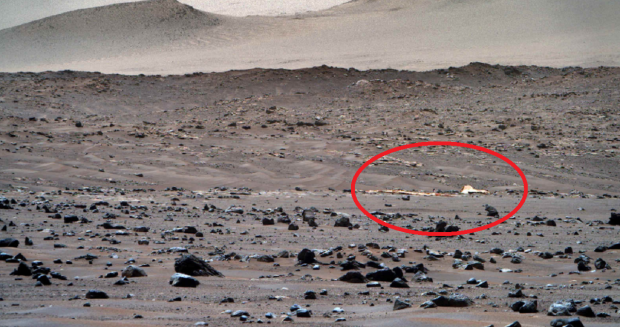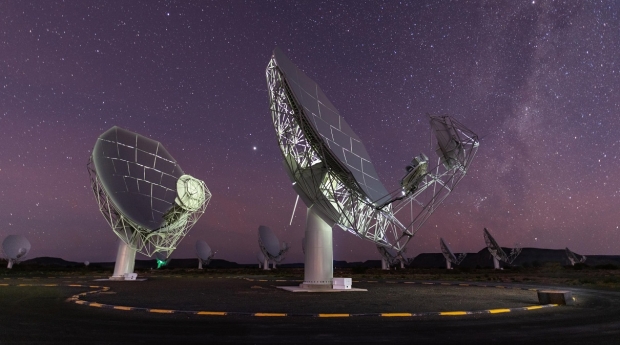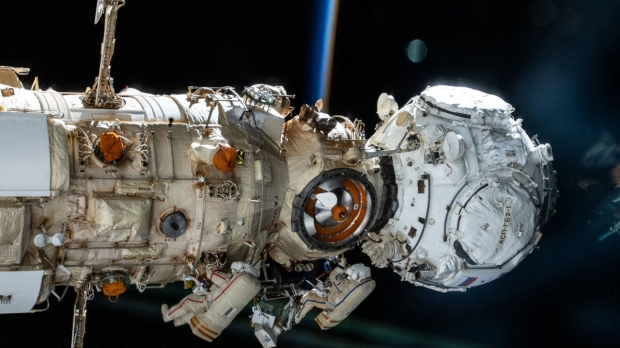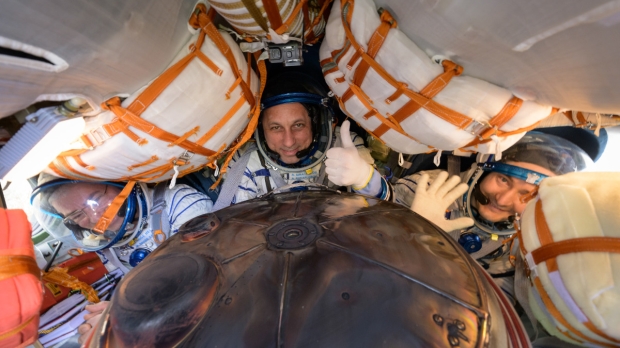Science, Space, Health & Robotics News - Page 161
Astronomers have found the most distant object in the universe yet
Studies on the galaxy titled "A Search for H-Dropout Lyman Break Galaxies at z~12-16" and "Are the Newly-Discovered z∼13 Drop-out Sources Starburst Galaxies or Quasars?" have been published in the Astrophysical Journal and Monthly Notices of the Royal Astronomical Society Letters, respectively.
Researchers have spotted HD1, a galaxy candidate approximately 13.5 billion light-years away from Earth. Two theories have been suggested regarding HD1; that it could be forming stars at a very high rate, potentially Population III stars (the first stars to be born in the universe, which have yet to be observed), or that HD1 may contain a supermassive black hole 100 million times the mass of our Sun.
"The very first population of stars that formed in the universe were more massive, more luminous and hotter than modern stars. If we assume the stars produced in HD1 are these first, or Population III, stars, then its properties could be explained more easily. In fact, Population III stars are capable of producing more UV light than normal stars, which could clarify the extreme ultraviolet luminosity of HD1," said Fabio Pacucci, lead author of the MNRAS study.
Continue reading: Astronomers have found the most distant object in the universe yet (full post)
Dinosaur leg from the day the deadly asteroid hit Earth found
Researchers have claimed that they have excavated a fossil of a dinosaur that died on the same day the asteroid that hit Earth and ended the time of the dinosaurs.
According to researchers led by Robert DePalma, a doctoral student at the University of Manchester, the fossilized dinosaur leg that was discovered is from a Thescelosaurus, a herbivore dinosaur that's name translates to "wonderful lizard" in ancient Greek. The dinosaur leg was found to have its skin attached to it, and according to researchers, there was no previous record of what the skin of the Thescelosaurus looked like before this discovery.
The team of researchers claims that the dinosaur's leg had been ripped off and buried during the asteroid impact that ended the dinosaurs' reign on Earth and created what has now been named the Chicxulub crater in the Yucatan Peninsula. Notably, Robert DePalma in 2019 reported finding fossilized fish that still had gills attached to them.
Continue reading: Dinosaur leg from the day the deadly asteroid hit Earth found (full post)
NASA's Mars rover has stumbled upon its own parachute, snaps pictures
NASA's Perseverance rover landed on the Red Planet in February 2021, and since then, it has been exploring the Jezero Crater.
Perseverance landed on Mars on February 18, 2021, and has since spent 414 days on Mars conducting science and taking images. The rover has ventured quite the distance and has taken several core samples of Martian rocks that will eventually be transported back to Earth. On April 6, the rover snapped some images of the terrain that surrounds it, and one hawk-eyed Twitter user identified what seems to be Perseverance's parachute in the background of one of the images.
The remains of the parachute, along with its exact location, were identified by NASA's Mars Reconnaissance Orbiter back in 2021, and according to reports, the location of the parachute is only half a mile south of Perseverance's current location, which means it may be possible that Perseverance's mast cam has enough perch to spot the year-old relic.
Continue reading: NASA's Mars rover has stumbled upon its own parachute, snaps pictures (full post)
Scientists detect record-breaking 'Bat Signal' laser out in deep space
An international team of researchers have reported observing what is now the oldest beam of microwave radiation, paving the way for more knowledge of the early years of the cosmos.
The scientists detected what is called a megamaser, which is a super-powerful laser that consists of microwave light. There are many types of these lasers, and the type that was detected by the researchers is the most common, hydroxyl. This signal consists of a molecule that is made up of one oxygen atom and one hydrogen atom. The team of researchers states that the detection of hydroxyl signals the collision of two galaxies, which results in new stars being born and any surrounding black holes being fed.
The laser that was detected by the researchers has been nicknamed Nkalakatha, which translates to "Big Boss" in isiZulu. The light that was observed is estimated to be about 5 billion years old, giving astronomers a glimpse into the chaotic past of the universe and information to test the future. The researchers used the MeerKAT Array, which features 64 receptors located in South Africa, and notably, it only took one night of observations to make a record-breaking discovery.
Continue reading: Scientists detect record-breaking 'Bat Signal' laser out in deep space (full post)
NASA's next crewed lunar rover will be built by a car manufacturer
Veteran space company Teledyne Brown Engineering announced it has partnered with Nissan on creating the next crewed Lunar Terrain Vehicle.
The announcement from Teledyne took place at the 37th Space Symposium in Colorado Springs, where the company with more than 70 years of experience in the space industry announced it would be partnering with Nissan, Sierra Space, and a few other companies to work on creating the next lunar rover.
According to a press release, Nissan has previously worked with NASA on autonomous mobility at the AMES Research Center and has displayed its experience with electric vehicles and a passion for space exploration. Nissan North America will be bringing its autonomous driving technology to the table, as well as its extensive history of high-quality engineering and design.
Continue reading: NASA's next crewed lunar rover will be built by a car manufacturer (full post)
NASA's rover spots something it hasn't seen in its 10 years on Mars
NASA's Curiosity rover has been exploring the large mountain called the "Greenheugh Pediment" for most of March and is now making its way back down the mountain's southern side.
The Curiosity team identified a problem ahead of the Mars rover that originally landed on the Red Planet back in August 2012. There was a large field of objects called "ventifacts" on the rover's route. These objects are rocks that have been sharpened from the harsh martian winds, and in the past, Curiosity's wheels have been damaged when the rover traverses over the terrain.
Notably, ventifacts are found all over Mars, but according to Phys.org, the field of ventifacts ahead of the rover was the most Curiosity has seen in its nearly 10 years on the Red Planet. NASA officials have nicknamed the sharp rocks "gator-back", as the rock resembles the rough scales on the back of an alligator. The Curiosity team is now mapping out a new course for the Mars rover that will take it through much safer terrain as it continues to explore the 3.4-mile-tall mountain it has called home since 2014, Mount Sharp.
Continue reading: NASA's rover spots something it hasn't seen in its 10 years on Mars (full post)
NASA explains the two major kinds of eruptions that happen on the Sun
The sun experiences many different types of eruptions, but two major types of eruptions occur on the sun's surface: solar flares and coronal mass ejections (CME).
NASA has taken to its blog and to the "NASA Goddard" YouTube channel to explain the difference between solar flares and CMEs. Solar flares and CMEs often occur at the same time but are very different as solar flares are giant bursts of X-rays and energy that travel at the speed of light in all directions. These flares come from the motion of the sun's interior, causing the magnetic field to build tension and then explosively realign, much like a rubber band.
A solar flare can last minutes to hours, and throughout that period, it releases a large amount of charged particles that can reach Earth in eight minutes or less. As for a CME, NASA explains magnetic contortions can also cause plasma from the sun's corona to be shot into space. This plasma is a wave or cloud of magnetized particles that travel at more than a million miles per hour and usually take about three days to reach Earth.
Continue reading: NASA explains the two major kinds of eruptions that happen on the Sun (full post)
The U.S. Navy's next 'doomsday plane' has just been unveiled
The United States Navy currently uses Boeing's E-6B Mercury aircraft as its doomsday plane.
The currently underway Sea-Air-Space Exposition saw the reveal of the next doomsday plane the U.S. navy will soon be using, now provided by Lockheed Martin instead of Boeing. The EC-130J, like the United States Air Force's E-4B doomsday plane and Russia's Ilyushin II-80 doomsday plane both serve to ensure that their nation's heads of state and top military personnel can remain in control in the event of nuclear war or other disastrous situations.
The U.S. navy uses such aircraft for what it calls the Take Charge And Move Out (TACAMO) missions. It has sixteen Boeing E-6B Mercury aircraft that can connect to and command submarines within the naval fleet that can deploy ballistic missiles. During the Cold War, Lockheed Martin's EC-130Q was used on TACAMO missions, and the company will now reprise its role in supplying aircraft with such missions with the EC-130J Hercules aircraft.
Continue reading: The U.S. Navy's next 'doomsday plane' has just been unveiled (full post)
Russia may abandon the ISS by 2024, experts say
NASA recently released plans for the International Space Station (ISS) to continue service until 2030.
However, Russia has only committed to supporting the ISS until 2024. The nation may use that opportunity, paired with recent sanctions on its space industry due to its invasion of Ukraine, to sever ties with the project. This would leave NASA responsible for keeping the space station in orbit for at least the rest of the decade, a task Russia is presently responsible for.
Dmitry Rogozin, the head of Roscosmos, Russia's space agency, has tweeted a variety of things alluding to Russia pulling out of the ISS following the sanctions imposed on the country and its space agency. On April 2nd, he tweeted to say that "normal relations" between Russia and its partners on the ISS would only return to normal with "the complete and unconditional lifting of illegal sanctions."
Continue reading: Russia may abandon the ISS by 2024, experts say (full post)
This NASA astronaut openly discussed Ukraine with Russian cosmonauts
Returning to Earth on a Soyuz spacecraft after record-breaking spaceflights, the trio had plenty of time to talk.
NASA astronaut Mark Vande Hei returned to Earth with his Russian crewmates from the International Space Station (ISS), cosmonauts Pyotr Dubrov and Anton Shkaplerov. Vande Hei said that everyone working on the space station continued working together as normal, despite the geopolitical turmoil on Earth taking place in the wake of Russia's invasion of Ukraine and the subsequent sanctions placed on Russia's space program.
"About my relationship with my Russian crewmates, they were, are, and will continue to be very dear friends of mine. We supported each other throughout everything. And I never had any concerns about my ability to continue working with them," said Vande Hei during a press conference.
Continue reading: This NASA astronaut openly discussed Ukraine with Russian cosmonauts (full post)











